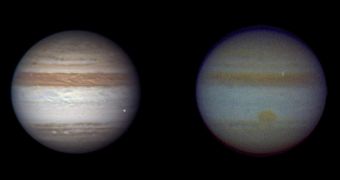This year marked the first instance ever when amateur astronomers were able to use Earth-based telescopes to see a duo if fireballs lighting up the Jovian atmosphere. The amateurs observed the events even before larger observatories did.
Now, a series of papers on the impacts is starting to emerge, published in various scientific journals. The cosmic events took place on June 3 and August 20, respectively.
The two impactors that struck the gas giant's surface left very visible scars as they did so. The marks were clearly visible to medium- and top-end backyard telescopes.
A new investigation was recently published, that was authored by astronomer Ricardo Hueso from the Universidad del País Vasco, in Bilbao, Spain, and which included both professional and amateur astronomers.
The work seeks to estimate that size of each of the two impactors, as well as their probable effects on the surface of Jupiter.
According to the data the group mustered up, it would appear that the June 3 impactor had a diameter of between 8 and 13 meters, or 30 to 40 feet.
Size-wise, this space rock was comparable to asteroid 2008 TC3, which burnt up in Earth's atmosphere above Sudan two years ago. It also had about the same dimensions as space rock 2010 RF12, which flew past Earth a couple of days ago.
“Jupiter is a big gravitational vacuum cleaner,” believes paper coauthor Glenn Orton, who is based in Pasadena, California, at the NASA Jet Propulsion Laboratory (JPL).
“It is clear now that relatively small objects, remnants of the formation of the solar system 4.5 billion years ago, still hit Jupiter frequently. Scientists are trying to figure out just how frequently,” the expert goes on to say.
Measurements seem to indicate that the June 3 impactor was in fact about the same size as the space rock that struck Earth in 1908, in the Tunguska region of Siberia.
Millions of trees were knocked to the ground at that time, but the space rock that hit Jupiter only had one tenth the strength of the Earth impactor, in spite of similar dimensions.
“It is interesting to note that whereas Earth gets smacked by a 10-meter-sized object about every 10 years on average, it looks as though Jupiter gets hit with the same-sized object a few times each month,” explains scientist Don Yeomans.
“The Jupiter impact rate is still being refined and studies like this one help to do just that,” says the scientist, who is also the manager of the JPL Near-Earth Object Program Office. He was not a part of the new research.

 14 DAY TRIAL //
14 DAY TRIAL //